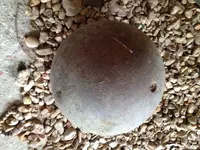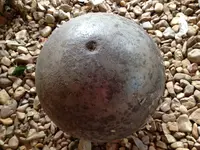Huntsman53, please take my word that my inclusion of my Professional Qualifications in my reply was not directed at you... nor anybody else who has posted in this discussion. I included my credentials because I know from experience that there's always going to be some readers who will wonder why they should believe that the information I provide is factually correct. As we all know, anybody can anything they want on the internet -- and often, what an anonymous somebody on the internet says turns out to be factually incorrect. So, I occasionally include my professional credentials to provide Credibility for what I say about artillery projectiles.
You are quite correct that a reasonable amount of caution is always advisable when a finder isn't sure whether an object is a "live" artillery projectile or not. I wrote my previous post to give readers reliable assurance that they don't need to call the Police about a cannonBALL. (And as I said, bullet-shaped artillery projectiles from the 20th-Century are a different matter, because some of that type can still be dangerous to drop.)
Now, answering your questions about this 4-tiny-holes ball:
I applaud you for "doing the math" which proves this ball is a hollow one, not solid all the way through. (As my Solid Shot Essentials article shows, that's a very important part of distinguishing Artillery balls from non-Artillery balls (such as ball-bearings, Sports Shot-Put balls, mining industry Mill-Balls, etc).
As evidence that I really have been studying these 4-tiny-holes steel balls for several decades, here's a photo showing one which cracked open when it fell off the back of a truck onto concrete pavement at a scrapyard.
Some people have theorized that these 4-tiny-holes steel balls are some kind of Incendiary cannonball. But, as I said in my prior post, the fact that NONE of them are the precisely-correct diameter for any caliber of cannon proves beyond doubt that they are not a Artillery ball.
For example, the US Ordnance Manual specifies that 10"-caliber cannonballs had to be precisely 9.87-inches in diameter, in order to correctly fit into the cannon's 10.0"-diameter bore. So, if a ball measures (let's say) 9.79-inches or 9.95 inches in diameter, it wouldn't correctly fit any known cannon, and therefore it is not a cannonball.
The precisely-measured diameter of the broken-open 4-tiny-holes ball in the photo below is 8.72-inches, which excludes it from being a cannonball.







 LOL!!! I don't know but thought I would throw some humor in to it.
LOL!!! I don't know but thought I would throw some humor in to it.